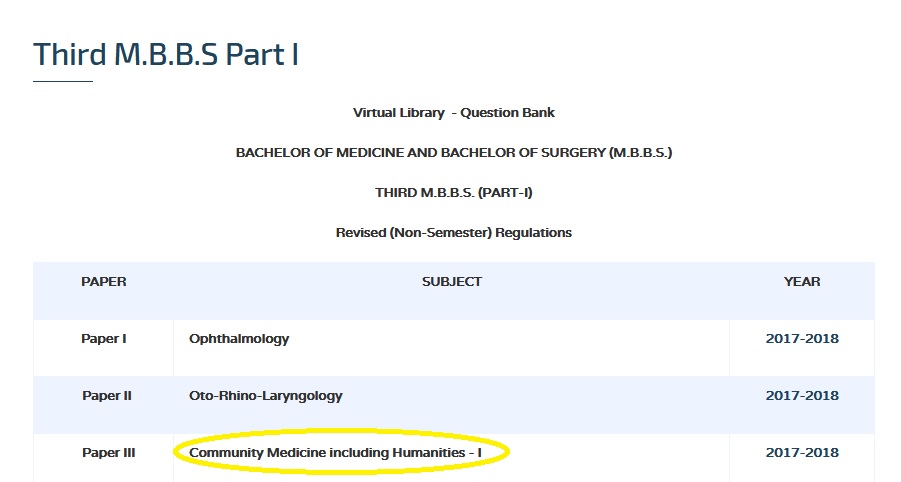Community Medicine-I MBBS Question Bank : web.tnmgrmu.ac.in
Name of the University : The Tamilnadu Dr. M.G.R. Medical University
Degree : Third M.B.B.S (Part-I)
Subject Code/Name : 4073 Community Medicine-I
Paper : III
Document Type : Question Bank
Website : web.tnmgrmu.ac.in
Download Model/Sample Question Paper :
2008-2014 :https://www.pdfquestion.in/uploads/we…7-524073LA.pdf
2001-2008 :https://www.pdfquestion.in/uploads/we…7-524073KU.pdf
TNMGRMU Community Medicine-I Question Bank
I. Essay Questions : (2 x 20 = 40)
1. Define source and reservoir of infection- Describe in detail dynamics and modes of disease transmission
Related / Similar Question Bank :
TNMGRMU Community Medicine-II Question Bank
2. Write the source air pollution- Describe the strategies regarding the preventing measures of air pollution in our country.

II. Write Short notes on : (10 x 6 = 60)
1. Epidemiological Triad.
2. Prenatal screening.
3. Cold chain system.
4. Sampling Methods.
5. Barriers of communications.
6. Lifestyle and health.
7. Dietary goals.
8. Merits and demerits of cohort study.
9. Healthful school Environment.
10. Mid Meal Programme.
III. Short Answer Questions : (10 x 2 = 20)
1. Write any two morbidity indicators.
2. Define sensitivity.
3. Case fatality rate and its significance.
4. Define balanced diet.
5. Somatic effects of radiation.
6. Define euthenics.
7. Write two methods of dietary survey.
8. Functions of family.
9. Smoke index.
10. Define rehabilitation.

February 2009 Question
I. Essay Questions : (2 x 20 = 40)
1. What is epidemiological triad. Describe in detail the agent, Host and environmental factors.
2. What is water pollution- Write in detail about water related diseases.
II. Write Short notes on : (10 x 6 = 60)
1. Changing concepts in Public Health.
2. Sensitivity & Specificity.
3. Types of ventilation.
4. Standard deviation.
5. Group discussion.
6. Primordial prevention.
7. Aflatoxins.
8. Proportional Mortality rate.
9. Child guidance clinic.
10. Vitamin A prophylaxis programme
III. Short Answer Questions : (10 x 2 = 20)
1. Write any two mortality indicators.
2. Types of family
3. Incidence.
4. Define Epidemiology.
5. Limiting Amino Acids.
6. Water Harvesting.
7. Genetic counselling.
8. Biological control of anti larval measures.
9. Define Health.
10. Sullivan’s Index.
August 2009 Question
I. Essay Questions : (2 x 20 = 40)
1.What are the types of analytical epidemiological study? Describe the steps involved in the case-control study.
2. What is National vector-borne disease control programme? Describe and discuss National Anti-Malarial Programme.
II. Write Short notes on : (10 x 6 = 60)
1. Tools of measurements in epidemiology.
2. Rehabilitation.
3. Prevention of Neo-natal tetanus.
4. Functions of world health organization.
5. Approach to health education.
6. Medical Record linkage.
7. Lead poisoning.
8. Chi-Square test.
9. Indices of thermal comfort.
10. Control of noise pollution.
III. Short Answer Questions : (10 x 2 = 20)
1. Concept of positive health.
2. Sullivan’s index.
3. Aims of epidemiology.
4. Secular trend.
5. Serial interval.
6. Sensitivity and specificity.
7. Passive surveillance in Tuberculosis.
8. Chandler’s index.
9. Annual parasite incidence (API).
10. DEC-Provocative test.
February 2010 Question
I. Essay Questions : (2 x 15 = 30)
1. Describe various levels of prevention and interventions with examples.
2. Discuss the epidemiology of tetanus.
II. Write Short notes on : (10 x 5 = 50)
1. Ice-berg phenomenon.
2. Soakage pit.
3. Histogram.
4. Bagassosis
5. Blocked flea.
6. Indices of thermal comfort.
7. Sanitary well.
8.Human development index.
9. Sanitation barrier.
10. Benefits of ESI Scheme.
III. Short Answer Questions : (10 x 2 = 20)
1. Uses of Epidemiology.
2. Measurement of morbidity.
3. Diagnosis of lead poisoning.
4. Differences between shallow and deepwell.
5. Annual parasite index.
6. Methods of disinfection.
7. Millenium development goals.
8. Sanitary landfill.
9. Ergonomics.
10. Population attributable risk.
August 2010 Question
I. Essay Questions : (2 x 15 = 30)
1. Define Pneumoconiosis. Explain the various measures for prevention of occupational diseases.
2. List the arboviral diseases. Explain the epidemiology, clinical features, control of Japanese encephalitis.
II. Write Short notes on : (10 x 5 = 50)
1. International classification of diseases.
2. Epidemic curve.
3. Purification of water on large scale.
4. Incidence rate and its uses.
5. Elements of Cohort study.
6. Refuse disposal methods in rural areas.
7. Basic steps in randomised control trial.
8. Sanitation barrier.
9. Natural history of measles.
10. Sampling error.
III. Short Answer Questions : (10 x 2 = 20)
1. Vision 2020.
2. Modifiable risk factors in hypertension.
3. Contact tracing in STD’s.
4. Morphological Index.
5. Anti Rodent Measures.
6. Microfilaria Rate.
7. Urban Malaria.
8. Accident Proneness.
9. Secondary attack rate.
10. PQLI (Physical Quality of Life Index).
February 2011 Question
I. Essay Questions : (2 x 10 = 20)
1. Discuss in detail the steps involved in conducting a cohort study. Mention the advantages and disadvantages of cohort study.
2. Describe briefly the epidemiology of tuberculosis. Add a note on the Revised National Tuberculosis Control Programme.
II. Write Short notes on : (10 x 5 = 50)
1. Normal Distribution.
2. Basic tools of measurement in epidemiology.
3. Strategies for Polio eradication in India.
4. Criteria for screening test.
5. Causes and effects of global warming.
6. Syndromic approach in sexually transmitted diseases.
7. Causes and prevention of Accidents in industry.
8. Lead poisoning.
9. Methods of disposal of solid wastes.
10. Presentation of statistical data.
III. Short Answer Questions : (15 x 2 = 30)
1. Disease elimination and eradication with example.
2. Primordial prevention with example.
3. Survival rate.
4. Sentinel Surveillance.
5. Biological transmission.
6. Herd Immunity.
7. Endemic Index.
8. Anthracosis.
9. Mention two frequently used Health Care Delivery Indicators.
10. Extrinsic incubation period.
11. Mention two diseases transmitted by Hard Ticks.
12. Brocca index.
13. Day light factor.
14. Mention two types of mechanical ventilation.
15. Disablement benefit under E.S.I. Act.
Can I get a sample on questions based on PBL in Community Medicine?